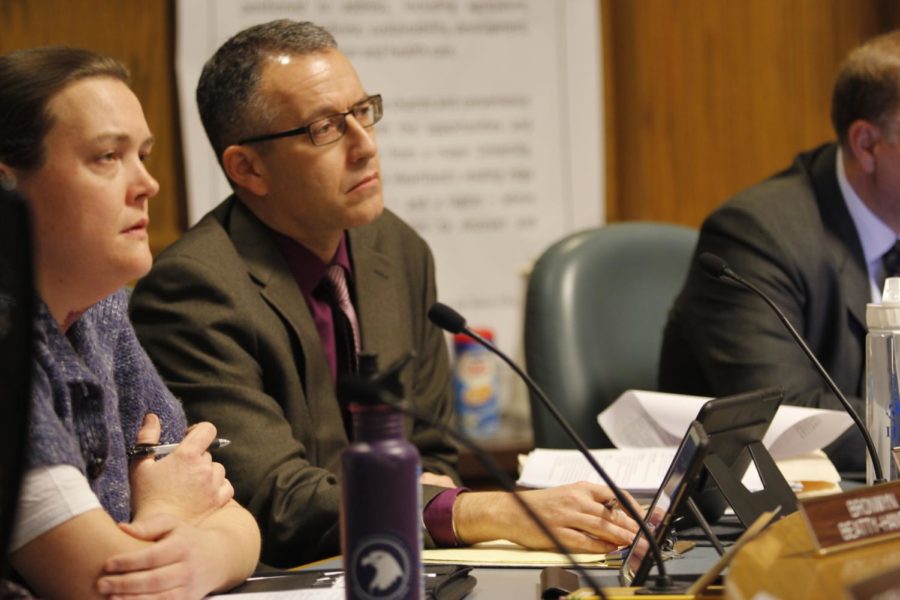City staff to introduce report on occupancy ordinance, suggests proactive housing enforcement
Chris Anderson/Iowa State Daily
City Council members Tim Gartin and Bronwyn Beatty-Hansen at a city council meeting on Feb 28.
September 12, 2017
In a report to the Ames City Council ahead of Tuesday’s meeting, city staff offered research conducted over the past several months regarding the issue of housing occupancy in rental units.
The city of Ames currently limits the number of people in rental units to one family or three unrelated people.
Because of a law passed during the previous State Legislative cycle that will go into effect Jan. 1, 2018, Iowa cities may not adopt or enforce any regulation restricting occupancy based on familial or non-familial relationships in rental properties.
Ahead of this, the city has gauged passing a new ordinance that would restrict occupancy in some capacity and has considered restricting by bedrooms, number of adults, parking spots, square footage, etc.
To get feedback on these ideas, the city staff – as requested by the council – held two workshops in August with landlords, property managers and neighborhood representatives to ask what they feel might work best for them and what would be the best approach for the city.
In results collected by city staff, the recommendations made by these stakeholders varied immensely.
As to whether or not the city should regulate occupancy, the majority of landlords said no, however, the neighborhood representatives said yes.
Should occupancy be enforced, the landlords displayed preference by bedroom whereas the neighborhoods prefer restriction by number of people.
In regard to enforcement of city code, the landlords preferred to be reactive and without occupancy enforcement with the neighborhood taking the opposite approach of being proactive.
The only question both landlords and neighborhood representatives agreed upon, however, was that the best way to regulate the percentage of rentals would be by block.
Per these results, the staff is recommending the creation of an additional housing inspector position that would increase enforcement to “accomplish proactive, complaint driven and scheduled inspection efforts.”
The creation of this position would cost $104,000 for the first-year total cost.
The report, also examined other cities to compare the way in which they restrict – or do not restrict – rentals within their city and neighborhoods. This is recognized as “rental concentration” and is done by establishing a limitation on the number of rental properties within a defined area or “block.”
Should the council choose to enact a restriction on rentals, the city staff recommended four options.
- Citywide definition: “The city can define a uniform standard of a “block” for establishing the rental percentage limitation. Following the block model would mean areas as bounded by streets would be the defined block. The size of these blocks will vary across the City.”
- Property owner petition for a zoning overlay: “The City could create an option for a Conservation District Overlay that would set rental limits within an individually defined area…Establishing an overlay would typically be based upon a minimum number of acres or properties and a requirement for a petition signed by a minimum percentage of property owners to have the City consider a rezoning request.”
- City Council initiated zoning overlay: “Rather than have a property initiated overlay, the City can apply a zoning overlay by its own volition. The City would create the terms of the Zoning Overlay in Zoning Ordinance and then proceed with the rezoning action for the defined area.”
- Separation requirement: “This approach would likely keep a distance of one or two properties between each rental to ensure there are not highly concentrated areas of single-family rental properties. “
The council will discuss this report during its meeting Tuesday at 6 p.m. as the council continues to consider the best route to take regarding inspection and nuisance enforcement, rental concentration and the possibility of converting rentals back to single-family units.

















